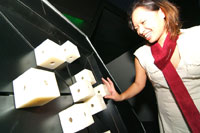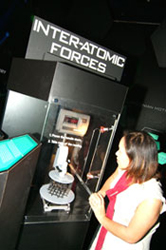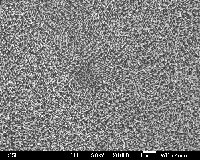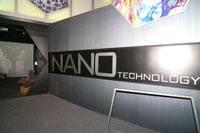Imagine having the power to heal yourself after a terrible accident, the way the character of Claire Bennett in NBC hit series Heroes does? Well, people could be waking up to such superpowers just years from now, thanks to nanotechnology.
 You know, the term Hewlett-Packard (HP) made popular a few years ago? Every HP advertisement across various media platforms bombarded consumers with this techie noun.
You know, the term Hewlett-Packard (HP) made popular a few years ago? Every HP advertisement across various media platforms bombarded consumers with this techie noun.
We bought the campaign and the products despite not necessarily knowing what nanotechnology was, ‘cos hey, it sounded cool enough to impress the amateur user.
If you’re thinking of going beyond being a geek wannabe, the Singapore Science Centre (SSC)’s new nanotechnology exhibition may shed light on the fascinating science of super smallness.
At the opening ceremony of the exhibition on Mar 16, Mr Lim Chuan Poh, Permanent Secretary, Ministry of Education (MOE), and Deputy Chairman of Agency for Science, Technology and Research (A*STAR), was obviously excited at the huge potential something so small we could never even see it.
He said, “[Nanotechnology] deals with matter smaller than 0.1 micron. This micron is about 1,000 times smaller than the diameter of a human hair, which is about 0.1 mm! And that is just the upper limit at which nanotechnology works. Its ultimate aim is the control of atoms and molecules, one at a time – to build something from the bottom up!”
Ok… So spare me the scientific lingo!
Dr Chew Tuan Chiong, Chief Executive of the SSC, explained that nanotechnology is the “notion of being able to manipulate matter on the level of atoms and molecules, and getting one single molecule to work on an individual level”.
 Here’s a nifty example. “Imagine there is a crack on a wall. With nanotechnology, we can program the molecules on the wall to repair the crack on its own.”
Here’s a nifty example. “Imagine there is a crack on a wall. With nanotechnology, we can program the molecules on the wall to repair the crack on its own.”
So we’re talking about something that’s similar to Claire Bennett’s astounding healing powers? Cool.
Let’s just say that it’s still not the time to start getting into accidents. Nanotechnology is not that advanced… yet. Research so far has only involved the reproduction of non-living cells.
“It may all sound very much like science fiction. But at the rate that nanotechnology is going, it could be in just a year or several years,” Dr Chew mused. Within 6 years, the worldwide total invested into research and development of nanotechnology went up by at least 24 times.
“In 1997, the worldwide total was less than US$500 million (S$ 762 649 600). By 2003, the total had risen to more than US$3 billion. By 2006, it was US$12 billion worldwide. The US National Science Foundation projects a global nanotechnology market growth of more than US$1 trillion over the next two decades,” Mr Lim added.
Where’s all the money going to?
Research has already brought about nanosilver and nanosomes, both bringing utmost benefits to mankind.
Silver has always been known for its antiseptic qualities and by integrating silver with nanotechnology; these qualities could be further enhanced to protect our bodies from bacterial and fungi infection.
 As for nanosomes which integrate the use of nanotechnology and cellular chromosomes, it’s being seen as an alternative form of cancer therapy. Dr Pan Kian Tiong, Senior Scientific Officer, Exhibitions Group for SSC, said, “Cancerous cells could be detected early before it manifests.” At the nanometer level, cancer could, hence, be detected at a very early stage and increase chances of survival.
As for nanosomes which integrate the use of nanotechnology and cellular chromosomes, it’s being seen as an alternative form of cancer therapy. Dr Pan Kian Tiong, Senior Scientific Officer, Exhibitions Group for SSC, said, “Cancerous cells could be detected early before it manifests.” At the nanometer level, cancer could, hence, be detected at a very early stage and increase chances of survival.
On a lighter note, the advancement of nanotechnology could also mean a faster serve for tennis players because the spaces of the racket at nanometer level are being filled up.
By doing so, more potential energy is transmitted to the strings of the racket, allowing the ball to be hit back with a force more powerful than before, using the same amount of strength.
Besides so, Dr Chew is expecting more job opportunities to spring up in this particular field of study. Most tertiary institutions are offering courses in nanotechnology or setting up research facilities within the school to facilitate learning to prepare youths to be equipped with sufficient knowledge to join the workforce upon graduation.
Woah! Where can I learn more?
SSC has recently launched the nation’s first nanotechnology exhibition which looks set to become a permanent fixture. Through a study of atoms and molecules, the exhibition will take visitors through an experiential journey beyond the naked eye.
The SSC is open from Tuesday to Sunday, from 10 am to 6 pm. Tickets are sold at $6, $3 and $3.60 for adults, children and senior citizens respectively. For further enquiries, please call 6425 2500.
All photos courtesy of The NUS Physics Department.

